
Unless noted otherwise, all works in this issue are licensed under a
Creative Commons Attribution-Noncommercial-No Derivative Works 3.0 License..
Nonfiction Zombie in a Dance Club
Tracy Stephenson Shaffer
(with photography by J.J. Alcantara and video edit by Mark Duplessis)
Flashback: The scene begins as a student’s dream. He posts it at the end of the summer as his Facebook status: “Mark Sidney Duplessis just had a dream about disco dancing zombies, culminating in a dance off between the slow moving zombies and the fast moving zombies while Staying Alive blared on the speakers. Then I woke up. (August 19, 2009 at 6:56 am).” Since I am preparing to direct a performance about zombies in the fall, I consider the image quickly for a moment, then dismiss it. I had already staged a “dance off” just two years earlier between King Kong and Godzilla to an iconic pop song. Yet, the idea remains lodged in my brain like some sharp object inflicted on the undead in an effort to relieve the creature of its ailment.
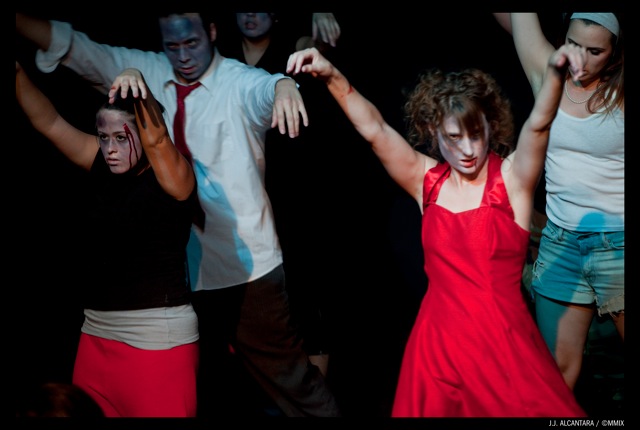
Flashforward: I am a few weeks into the rehearsal process for Nonfiction Zombie, an original ensemble performance about the zombie, its rise in popularity over the last decade, and its power as a cultural metaphor for many of our contemporary woes. I cast ten “zombies,” five graduate students/five undergrads, five women/five men, and like the beginning of the second act of many zombie films, we create our own little utopic world inside of the dystopic stresses of putting up a show on a deadline. We work together harmoniously devising scenes that either illustrate the multiple texts zombies inhabit (films, fiction, poetry, etc.) or contemplate what we call “a phenomenology of the zombie” (how the zombie transforms, consumes, invades, etc.) Each scene builds toward a better understanding of the monster and its metaphoric potential. But we need a scene that highlights the differences between slow zombies and fast zombies.
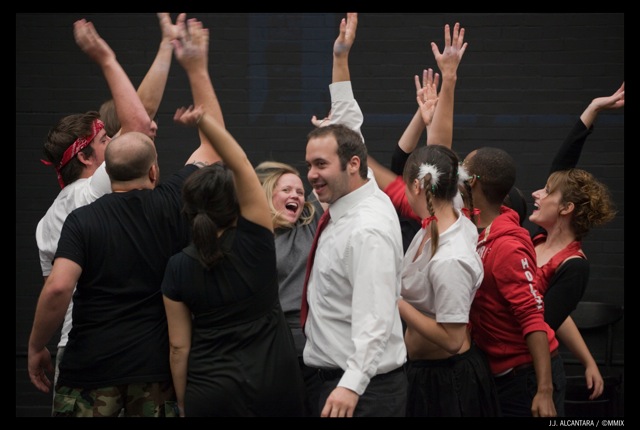
Exposition: I teach a course in our department called “The Horror Genre.” I teach it about once every other year, and it’s become a relatively popular course among students as well as one of my favorite courses to teach. I move chronologically through the genre, starting with the German expressionist films The Cabinet of Dr. Caligari (1920) and Nosferatu (1922) and ending in the present with films like 28 Days Later (2002) and The Descent (2005). We approach the films multimethodologically. That is, we analyze the genre from many angles: art, history, narrative, and gender, to name a few. One semester, I assigned Andrew Tudor’s Monsters and Mad Scientists as our text. In it, Tudor argues (quantitatively) that the primary filmic monster prior to 1960 was the supernatural vampire (representing a fear of the other), which was then replaced post-Psycho with the secular serial killer (representing a fear of the self). Tudor’s text was published in the late 1980s.
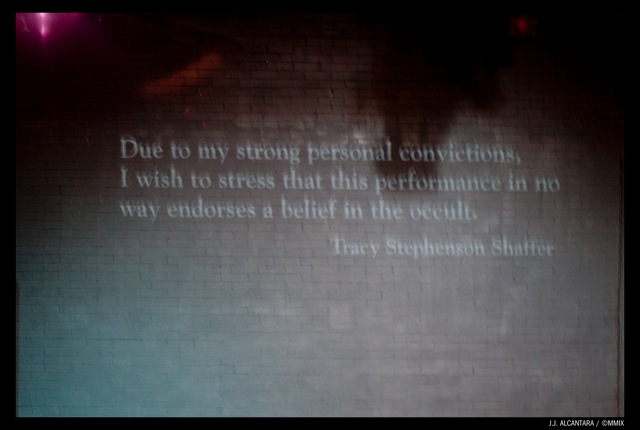
Inciting Incident: After teaching the course several times and keeping up with contemporary trends, I begin to argue in class that the zombie (while maybe not winning a quantitative war, yet) was moving from the margins and gaining on the serial killer. I offer a range of theories and wonder aloud what Tudor might argue if he revised his text. The question begins to take center stage in my mind. So, in the spring of 2009, I offer a special topics course called “The Zombie as Cultural Metaphor.” I hope the course will offer my students a closer look at a subgenre of film as well as help us theorize the zombie’s “rise” in popular culture. In addition, the course functions as dramaturgy for a future performance about zombies, proposed for the fall of 2009 in the HopKins Black Box at Louisiana State University. In the course, students screen at least one zombie film a week, read and discuss scholarly texts on zombies, and create performance assignments that communicate their discoveries. An assignment entitled “Zombies R Us,” due near the end of the semester, reveals students’ interpretations of the zombie as a metaphor for contemporary life. For example, one student, Jude Dupont, who subsequently takes part in the production, stages the zombie as a member of a cover band, singing the same song, Radiohead’s “Creep,” over and over again.
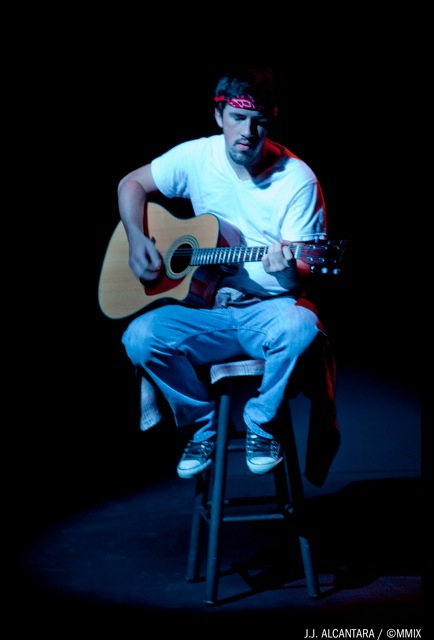
Rising Action: If there’s one thing I know about the show before I even begin, I know that I’ll play with popular music and that my cast will dance. So I prepare the audition with that in mind. I begin by alerting those auditioning to this fact, “We will be dancing in this show. The greatest music video of all time had dancing zombies. I need to know if you can keep a beat.” I simply ask them to walk across the floor to Justin Timberlake’s “Love Stoned.” They fall in line like soldiers. One by one, they cross the black length of the space as JT sings, “She’s freaky!” Some amble awkwardly; others prance like models on a catwalk. JT sings, “I like it!” We spend the majority of the audition doing this. They walk to the beat. They walk double time, moving twice as fast. They walk half time, stretching their steps until they remind me of slow motion film. Like Mark’s dream, this gets lodged in my brain somewhere. Like the dead in a zombie film, this moment will return.
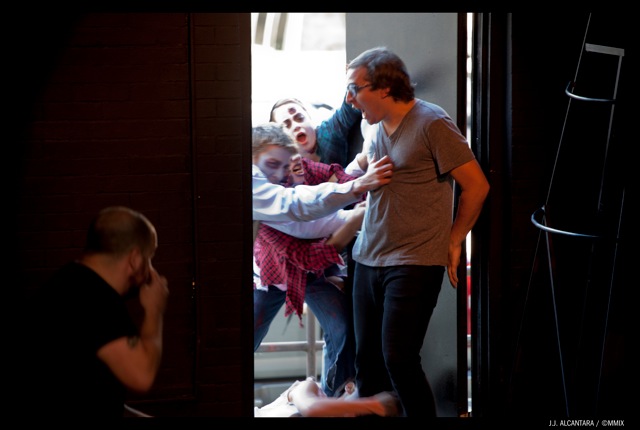
Climax: We need a scene that highlights the differences between slow zombies and fast zombies. A “phenomenology of the zombie” would be incomplete without the scene. But we can’t just have a “dance off.” The idea is fun, but it gets us nowhere. My audience already knows slow zombies and fast zombies exist. At minimum, we must compare the two, not just what they look and move like but when and where and how and even why they are different. I want the scene to theorize these differences as well. Complicated arguments exist that play the slow moving zombie against the fast as a sign of a changing world, of the changing human. Scholarly essays juxtapose the voodoo zombie ruled by some master with zombies that seem to move on their own initiative (or not). For example, my colleagues Joshua Gunn and Shaun Treat employ the different zombies to discuss how rhetorical scholars imagine ideology. Because of the immediacy and pace of performance, I know not to attempt to work carefully through these ideas on stage. I hate “talking heads” in performance. Besides, if you cut a zombie’s head off from its body, it no longer exists. I need to find a context in which we can encapsulate (or quarantine, if you will) our analysis, one that the audience already understands. I decide on a dance club for what it can offer: slow dancers (dancing in half time) and fast dancers (dancing double time) in the same space, narrated by a couple of dudes (think Saturday Night Fever meets Saturday Night Live) speaking audience-friendly theory. I draw from three primary texts to create the scene: Mark’s dream, K. Silem Mohammad’s “Zombies, Rest, and Motion: Spinoza and the Speed of Undeath” in The Undead and Philosophy, and George Romero’s Dawn of the Dead (1978), the first zombie film to make blatant the metaphor between zombies and contemporary American life.
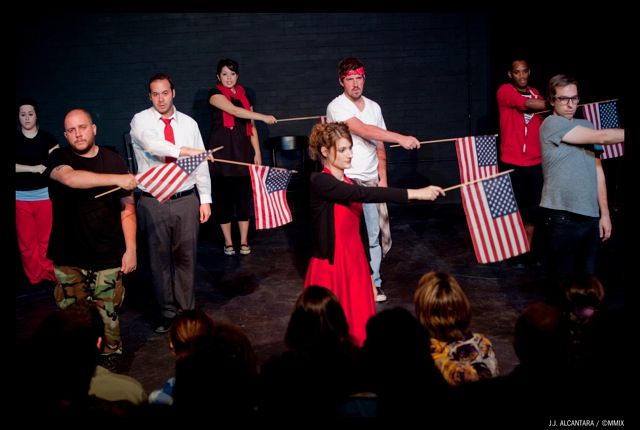

Flashforward: I am a few weeks into the rehearsal process for Nonfiction Zombie, an original ensemble performance about the zombie, its rise in popularity over the last decade, and its power as a cultural metaphor for many of our contemporary woes. I cast ten “zombies,” five graduate students/five undergrads, five women/five men, and like the beginning of the second act of many zombie films, we create our own little utopic world inside of the dystopic stresses of putting up a show on a deadline. We work together harmoniously devising scenes that either illustrate the multiple texts zombies inhabit (films, fiction, poetry, etc.) or contemplate what we call “a phenomenology of the zombie” (how the zombie transforms, consumes, invades, etc.) Each scene builds toward a better understanding of the monster and its metaphoric potential. But we need a scene that highlights the differences between slow zombies and fast zombies.

Exposition: I teach a course in our department called “The Horror Genre.” I teach it about once every other year, and it’s become a relatively popular course among students as well as one of my favorite courses to teach. I move chronologically through the genre, starting with the German expressionist films The Cabinet of Dr. Caligari (1920) and Nosferatu (1922) and ending in the present with films like 28 Days Later (2002) and The Descent (2005). We approach the films multimethodologically. That is, we analyze the genre from many angles: art, history, narrative, and gender, to name a few. One semester, I assigned Andrew Tudor’s Monsters and Mad Scientists as our text. In it, Tudor argues (quantitatively) that the primary filmic monster prior to 1960 was the supernatural vampire (representing a fear of the other), which was then replaced post-Psycho with the secular serial killer (representing a fear of the self). Tudor’s text was published in the late 1980s.

Inciting Incident: After teaching the course several times and keeping up with contemporary trends, I begin to argue in class that the zombie (while maybe not winning a quantitative war, yet) was moving from the margins and gaining on the serial killer. I offer a range of theories and wonder aloud what Tudor might argue if he revised his text. The question begins to take center stage in my mind. So, in the spring of 2009, I offer a special topics course called “The Zombie as Cultural Metaphor.” I hope the course will offer my students a closer look at a subgenre of film as well as help us theorize the zombie’s “rise” in popular culture. In addition, the course functions as dramaturgy for a future performance about zombies, proposed for the fall of 2009 in the HopKins Black Box at Louisiana State University. In the course, students screen at least one zombie film a week, read and discuss scholarly texts on zombies, and create performance assignments that communicate their discoveries. An assignment entitled “Zombies R Us,” due near the end of the semester, reveals students’ interpretations of the zombie as a metaphor for contemporary life. For example, one student, Jude Dupont, who subsequently takes part in the production, stages the zombie as a member of a cover band, singing the same song, Radiohead’s “Creep,” over and over again.

Rising Action: If there’s one thing I know about the show before I even begin, I know that I’ll play with popular music and that my cast will dance. So I prepare the audition with that in mind. I begin by alerting those auditioning to this fact, “We will be dancing in this show. The greatest music video of all time had dancing zombies. I need to know if you can keep a beat.” I simply ask them to walk across the floor to Justin Timberlake’s “Love Stoned.” They fall in line like soldiers. One by one, they cross the black length of the space as JT sings, “She’s freaky!” Some amble awkwardly; others prance like models on a catwalk. JT sings, “I like it!” We spend the majority of the audition doing this. They walk to the beat. They walk double time, moving twice as fast. They walk half time, stretching their steps until they remind me of slow motion film. Like Mark’s dream, this gets lodged in my brain somewhere. Like the dead in a zombie film, this moment will return.

Climax: We need a scene that highlights the differences between slow zombies and fast zombies. A “phenomenology of the zombie” would be incomplete without the scene. But we can’t just have a “dance off.” The idea is fun, but it gets us nowhere. My audience already knows slow zombies and fast zombies exist. At minimum, we must compare the two, not just what they look and move like but when and where and how and even why they are different. I want the scene to theorize these differences as well. Complicated arguments exist that play the slow moving zombie against the fast as a sign of a changing world, of the changing human. Scholarly essays juxtapose the voodoo zombie ruled by some master with zombies that seem to move on their own initiative (or not). For example, my colleagues Joshua Gunn and Shaun Treat employ the different zombies to discuss how rhetorical scholars imagine ideology. Because of the immediacy and pace of performance, I know not to attempt to work carefully through these ideas on stage. I hate “talking heads” in performance. Besides, if you cut a zombie’s head off from its body, it no longer exists. I need to find a context in which we can encapsulate (or quarantine, if you will) our analysis, one that the audience already understands. I decide on a dance club for what it can offer: slow dancers (dancing in half time) and fast dancers (dancing double time) in the same space, narrated by a couple of dudes (think Saturday Night Fever meets Saturday Night Live) speaking audience-friendly theory. I draw from three primary texts to create the scene: Mark’s dream, K. Silem Mohammad’s “Zombies, Rest, and Motion: Spinoza and the Speed of Undeath” in The Undead and Philosophy, and George Romero’s Dawn of the Dead (1978), the first zombie film to make blatant the metaphor between zombies and contemporary American life.

ON MOVEMENT . . .
Written by Tracy Stephenson Shaffer
(inspired primarily by Mark Duplessis’ dream,
K. Silem Mohammad’s “Zombies, Rest, and Motion,”
and George Romero’s Dawn of the Dead)
Written by Tracy Stephenson Shaffer
(inspired primarily by Mark Duplessis’ dream,
K. Silem Mohammad’s “Zombies, Rest, and Motion,”
and George Romero’s Dawn of the Dead)
(The scene consists of five slow dancers, two fast dancers, and two observer/narrators. The Bee Gees’ “Staying Alive” is playing and the dancers are dancing to it. The slow dancers dance to the song in half time, and the fast dancers dance to the song in double time.)
(Narrators hold their drinks and watch the five slow dancers.)
N1: How did we get in this hell hole?
N2: Well, when there’s no more room in hell, they come here. (laughs)
N1: Really, why do you think they come here?
N2: These creatures are nothing but pure, motorized instinct.
N1: Do you ever wish you were one of them?
N2: No way, man. Those are some seriously shambling, cadaverous beings. Their creepy lumbering motions make me uncomfortable.
N1: Yeah, for the most part, they do seem to be separated from their consciousnesses.
N2: They are on automatic, man. If I ever act like one of them, you can just shoot me in the head.
N1: (laughs)
N2: Seriously man! For example, check that dude out.
(One of the male dancers keeps making the move on the female dancers who ignore him. He keeps trying, regardless.)
N2: That dude is relentless.
N1: Yeah, but he’s pretty harmless. He’s so slow; they evade him pretty easily by distancing themselves from him and fortifying themselves in groups.
N2: But he never gives up! He’s slow and methodical, and ultimately . . .

(He begins to dance with one of the women.)
N2: highly efficient!
N1: Do these freaks ever get a clue?
N2: Sure, but they’re like ants. When these die off, they’re replaced by more of the same. Like Mother Theresa’s poor, they’re always with us. They’re hungry, unruly, unattractive, and no one wants to become one of them. But you can avoid them if you really try.
(A woman walks up and attempts to dance with N1; he avoids her by crossing the room.)
N1: Hungry?
N2: For flesh man. In some ways, these pathetic beings are poignant embodiments of desire.
N1: Poignant embodiments of desire? But you said they were “mindless!”
N2: More like single-minded.
(Two fast dancers take over the dance floor.)
N1: Check out those maniacs!
N2: Yeah, they’re a relatively new addition to this scene. You think those slow mothers are annoying. These nimble creatures take the cake!
N1: Why do they move like that?
N2: Some say it’s chemical.
N1: I beg your pardon?
N2: Chemical . . . rather than instinctual. And there’s no desire either. No hunger. Just aggression. Raw violence.
N1: Wow! You either join ‘em, or you’re doomed.
N2: There’s no avoiding them. They are up in your face before you can count to three! They’ll go on and on like that until they wear themselves completely out.
(During this talk, the same woman attempts to dance with N1 again. He complies. )
N2: It’s no use! Resistance is futile. (He joins in with the fast.)
(Fade Lights)
Falling Action: Both Romero and Mohammad’s texts warn against the (Real) threat of contemporary life. Romero places his main characters inside an abandoned mall where they observe slow moving pathetic zombies instinctually drawn there by either some residual desire or imminent hunger. The humans evade the creatures with relative ease at first, but the undead just keep coming, threatening a future apocalypse, unless things change. Mohammad argues that fast zombies, the ones that, not surprisingly, command our attention in the 2004 remake of Dawn of the Dead, move beyond being symbols of “repressed anxiety or desire; they are the radically embodied, limit-breaking consequences of repression in its social totality …” (101). In other words, when you are in a dance club, you can probably avoid the disco dancing fools, at least for a while, but if the dance floor turns into a mosh pit, you’re likely to get hurt.

Dénouement: As I reflect on the show, particularly the story of this scene, I realize I am becoming a mashup artist, a compiler of contemporary texts and ideas. I work on my individual research topics for approximately two years. I engage them using the classes I teach as well as personal reading/screening. Everything and everyone I encounter during that time becomes a possible transparency I place over my current project to see what emerges. I let my ideas germinate. I try to listen, to be aware. Eventually, something takes hold of me. Like a victim of the zombie, I look unchanged at first. To some, I may even seem dead, but the events breed a metamorphosis; the reawakening begins.
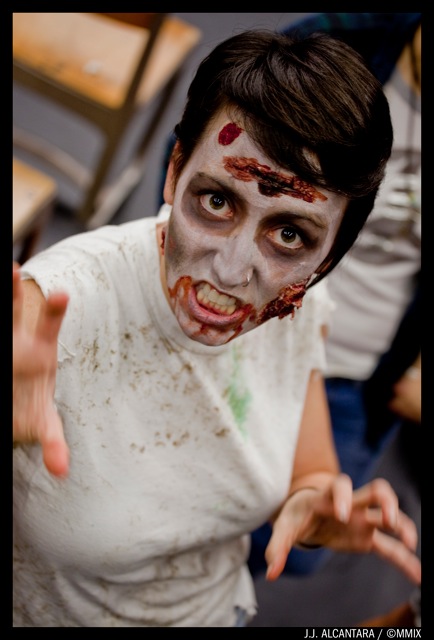
Works Cited
Dawn of the Dead. Screenplay by George A. Romero. Dir. by George A. Romero. The Laurel Group, 1978.
Dawn of the Dead. Screenplay by George A. Romero (1978) and James Gunn. Dir. by Zack Snyder. Strike Entertainment, 2004.
Gunn Joshua and Shaun Treat. “Zombie Trouble: A Propaedeutic on Ideological Subjectification and the Unconscious.” Quarterly Journal of Speech 91 (2005): 144-174.
Jackson, Michael. “Thriller.” Thriller. Epic Records, 1982. Music Video. Dir. John Landis. MTV. December 2, 1983.
Mohammad, K. Silem. “Zombies, Rest and Motion: Spinoza and the Speed of Undeath.” The Undead and Philosophy: Chicken Soup for the Soulless. Eds. Richard Greene and K. Silem Mohammad. Chicago: Open Court, 2006.
Radiohead. “Creep.” Pablo Honey. EMI, 1993.
Shaffer, Tracy Stephenson. Nonfiction Zombie. HopKins Black Box, Louisiana State University, Baton Rouge. 14 Oct 2009.
Shaffer, Tracy Stephenson. “Mapping Mediatization in The Life and Times of King Kong.” Liminalities: A Journal of Performance Studies 4:3 (2008).
Timberlake, Justin. “Love Stoned.” FutureSex/LoveSounds. Jive, 2006.
Tudor, Andrew. Monsters and Mad Scientists: A Cultural History of the Horror Movie. Oxford: Basil Blackwell, 1989.
***
Thanks to the Nonfiction Zombie Production Team:
Assistant Director: Sarah K. Jackson
Video Artist: J.J. Alcantara
Lights: Danielle Sears Vignes
Sound: Dolonel “Tal” Johnson
Lighting Design: Ruth Laurion Bowman
Lighting Consultant: John LeBret
Props/Make-up: Michelle Daigle
House Managers: Lisa Flanagan and Cory Rhodus
Sound Engineer: Benjamin D. Powell
Display Case Art: Amanda Stephenson
Publicity: Trish Suchy
Extra Zombies: Leighann Armand, Jordan Cheatham, Nathan Schreiber, Diana Shonkoff
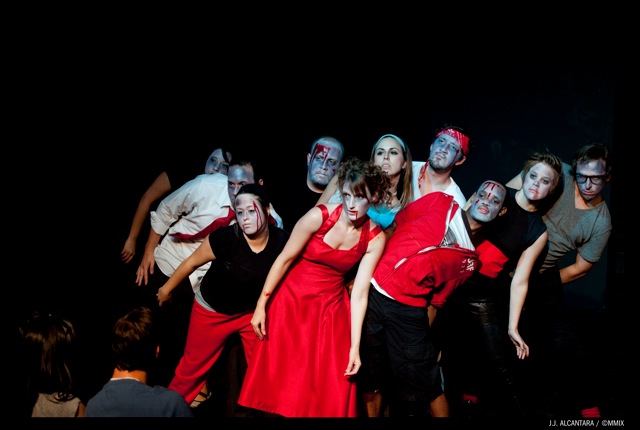
and the ensemble: Mollye Deloach, Mark Duplessis, Jude Dupont, Benjamin Haas, Sarah K. Jackson, Elizabeth Larrimore, Danielle McGeough, Casey Miller, Debra Odo, Michael Sanders
Additional Thanks: Doug and Sara Shaffer, Melissa and Melvin Stephenson, Tim Miller, the participants of the 2007 “The Mountain” Performance Artist Retreat, Lisa, Melanie, Gretchen, David, Rebecca, Holley, my lighting crew: Ruth, Mark, Jade, Emily, Dolonel, Derek, Cory, and Nathan, anyone who “gifted” me with something having to do with zombies in the last few years (you are too many to name), my colleagues in the Department of Communication Studies, Lisa Landry and Ginger Conrad, and my Spring 2008 “The Zombie as Cultural Metaphor” class.
(Narrators hold their drinks and watch the five slow dancers.)
N1: How did we get in this hell hole?
N2: Well, when there’s no more room in hell, they come here. (laughs)
N1: Really, why do you think they come here?
N2: These creatures are nothing but pure, motorized instinct.
N1: Do you ever wish you were one of them?
N2: No way, man. Those are some seriously shambling, cadaverous beings. Their creepy lumbering motions make me uncomfortable.
N1: Yeah, for the most part, they do seem to be separated from their consciousnesses.
N2: They are on automatic, man. If I ever act like one of them, you can just shoot me in the head.
N1: (laughs)
N2: Seriously man! For example, check that dude out.
(One of the male dancers keeps making the move on the female dancers who ignore him. He keeps trying, regardless.)
N2: That dude is relentless.
N1: Yeah, but he’s pretty harmless. He’s so slow; they evade him pretty easily by distancing themselves from him and fortifying themselves in groups.
N2: But he never gives up! He’s slow and methodical, and ultimately . . .

(He begins to dance with one of the women.)
N2: highly efficient!
N1: Do these freaks ever get a clue?
N2: Sure, but they’re like ants. When these die off, they’re replaced by more of the same. Like Mother Theresa’s poor, they’re always with us. They’re hungry, unruly, unattractive, and no one wants to become one of them. But you can avoid them if you really try.
(A woman walks up and attempts to dance with N1; he avoids her by crossing the room.)
N1: Hungry?
N2: For flesh man. In some ways, these pathetic beings are poignant embodiments of desire.
N1: Poignant embodiments of desire? But you said they were “mindless!”
N2: More like single-minded.
(Two fast dancers take over the dance floor.)
N1: Check out those maniacs!
N2: Yeah, they’re a relatively new addition to this scene. You think those slow mothers are annoying. These nimble creatures take the cake!
N1: Why do they move like that?
N2: Some say it’s chemical.
N1: I beg your pardon?
N2: Chemical . . . rather than instinctual. And there’s no desire either. No hunger. Just aggression. Raw violence.
N1: Wow! You either join ‘em, or you’re doomed.
N2: There’s no avoiding them. They are up in your face before you can count to three! They’ll go on and on like that until they wear themselves completely out.
(During this talk, the same woman attempts to dance with N1 again. He complies. )
N2: It’s no use! Resistance is futile. (He joins in with the fast.)
(Fade Lights)
Falling Action: Both Romero and Mohammad’s texts warn against the (Real) threat of contemporary life. Romero places his main characters inside an abandoned mall where they observe slow moving pathetic zombies instinctually drawn there by either some residual desire or imminent hunger. The humans evade the creatures with relative ease at first, but the undead just keep coming, threatening a future apocalypse, unless things change. Mohammad argues that fast zombies, the ones that, not surprisingly, command our attention in the 2004 remake of Dawn of the Dead, move beyond being symbols of “repressed anxiety or desire; they are the radically embodied, limit-breaking consequences of repression in its social totality …” (101). In other words, when you are in a dance club, you can probably avoid the disco dancing fools, at least for a while, but if the dance floor turns into a mosh pit, you’re likely to get hurt.

Dénouement: As I reflect on the show, particularly the story of this scene, I realize I am becoming a mashup artist, a compiler of contemporary texts and ideas. I work on my individual research topics for approximately two years. I engage them using the classes I teach as well as personal reading/screening. Everything and everyone I encounter during that time becomes a possible transparency I place over my current project to see what emerges. I let my ideas germinate. I try to listen, to be aware. Eventually, something takes hold of me. Like a victim of the zombie, I look unchanged at first. To some, I may even seem dead, but the events breed a metamorphosis; the reawakening begins.

Works Cited
Dawn of the Dead. Screenplay by George A. Romero. Dir. by George A. Romero. The Laurel Group, 1978.
Dawn of the Dead. Screenplay by George A. Romero (1978) and James Gunn. Dir. by Zack Snyder. Strike Entertainment, 2004.
Gunn Joshua and Shaun Treat. “Zombie Trouble: A Propaedeutic on Ideological Subjectification and the Unconscious.” Quarterly Journal of Speech 91 (2005): 144-174.
Jackson, Michael. “Thriller.” Thriller. Epic Records, 1982. Music Video. Dir. John Landis. MTV. December 2, 1983.
Mohammad, K. Silem. “Zombies, Rest and Motion: Spinoza and the Speed of Undeath.” The Undead and Philosophy: Chicken Soup for the Soulless. Eds. Richard Greene and K. Silem Mohammad. Chicago: Open Court, 2006.
Radiohead. “Creep.” Pablo Honey. EMI, 1993.
Shaffer, Tracy Stephenson. Nonfiction Zombie. HopKins Black Box, Louisiana State University, Baton Rouge. 14 Oct 2009.
Shaffer, Tracy Stephenson. “Mapping Mediatization in The Life and Times of King Kong.” Liminalities: A Journal of Performance Studies 4:3 (2008).
Timberlake, Justin. “Love Stoned.” FutureSex/LoveSounds. Jive, 2006.
Tudor, Andrew. Monsters and Mad Scientists: A Cultural History of the Horror Movie. Oxford: Basil Blackwell, 1989.
***
Thanks to the Nonfiction Zombie Production Team:
Assistant Director: Sarah K. Jackson
Video Artist: J.J. Alcantara
Lights: Danielle Sears Vignes
Sound: Dolonel “Tal” Johnson
Lighting Design: Ruth Laurion Bowman
Lighting Consultant: John LeBret
Props/Make-up: Michelle Daigle
House Managers: Lisa Flanagan and Cory Rhodus
Sound Engineer: Benjamin D. Powell
Display Case Art: Amanda Stephenson
Publicity: Trish Suchy
Extra Zombies: Leighann Armand, Jordan Cheatham, Nathan Schreiber, Diana Shonkoff

and the ensemble: Mollye Deloach, Mark Duplessis, Jude Dupont, Benjamin Haas, Sarah K. Jackson, Elizabeth Larrimore, Danielle McGeough, Casey Miller, Debra Odo, Michael Sanders
Additional Thanks: Doug and Sara Shaffer, Melissa and Melvin Stephenson, Tim Miller, the participants of the 2007 “The Mountain” Performance Artist Retreat, Lisa, Melanie, Gretchen, David, Rebecca, Holley, my lighting crew: Ruth, Mark, Jade, Emily, Dolonel, Derek, Cory, and Nathan, anyone who “gifted” me with something having to do with zombies in the last few years (you are too many to name), my colleagues in the Department of Communication Studies, Lisa Landry and Ginger Conrad, and my Spring 2008 “The Zombie as Cultural Metaphor” class.

